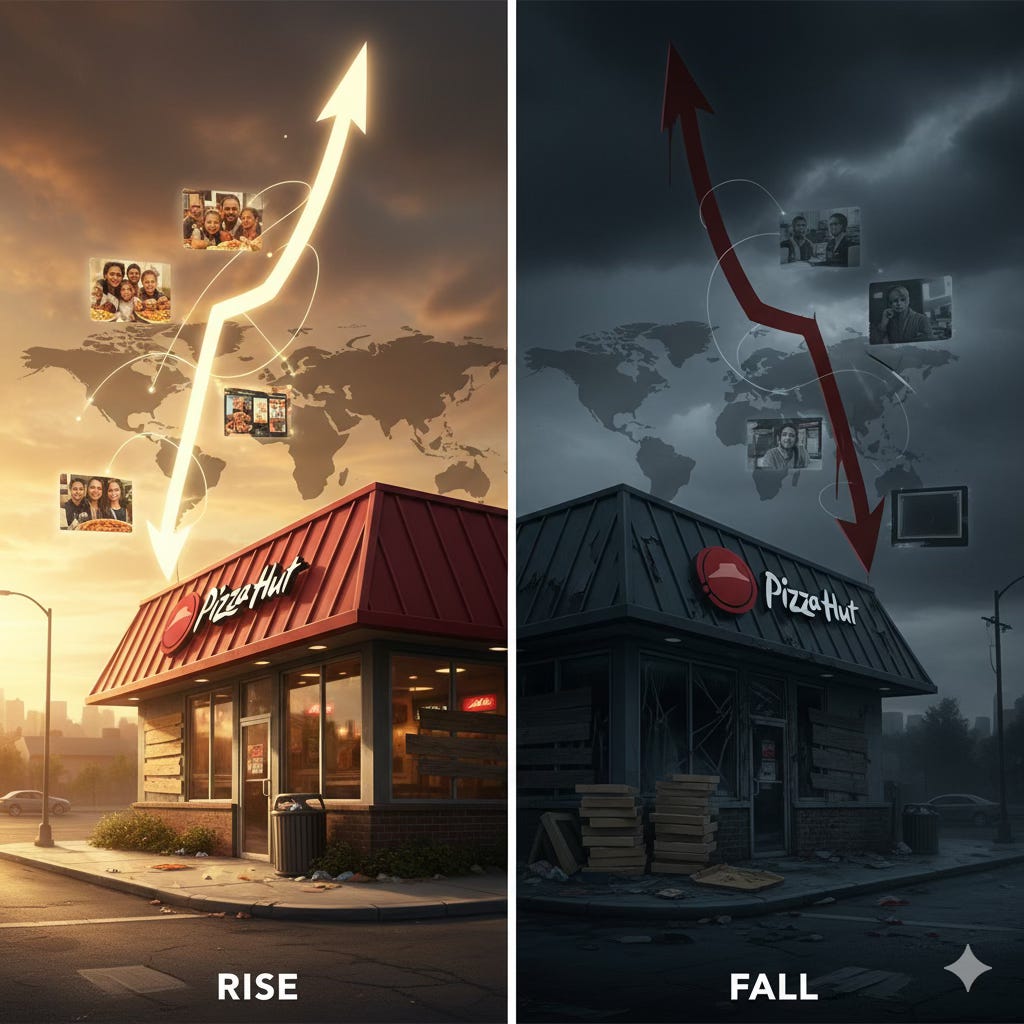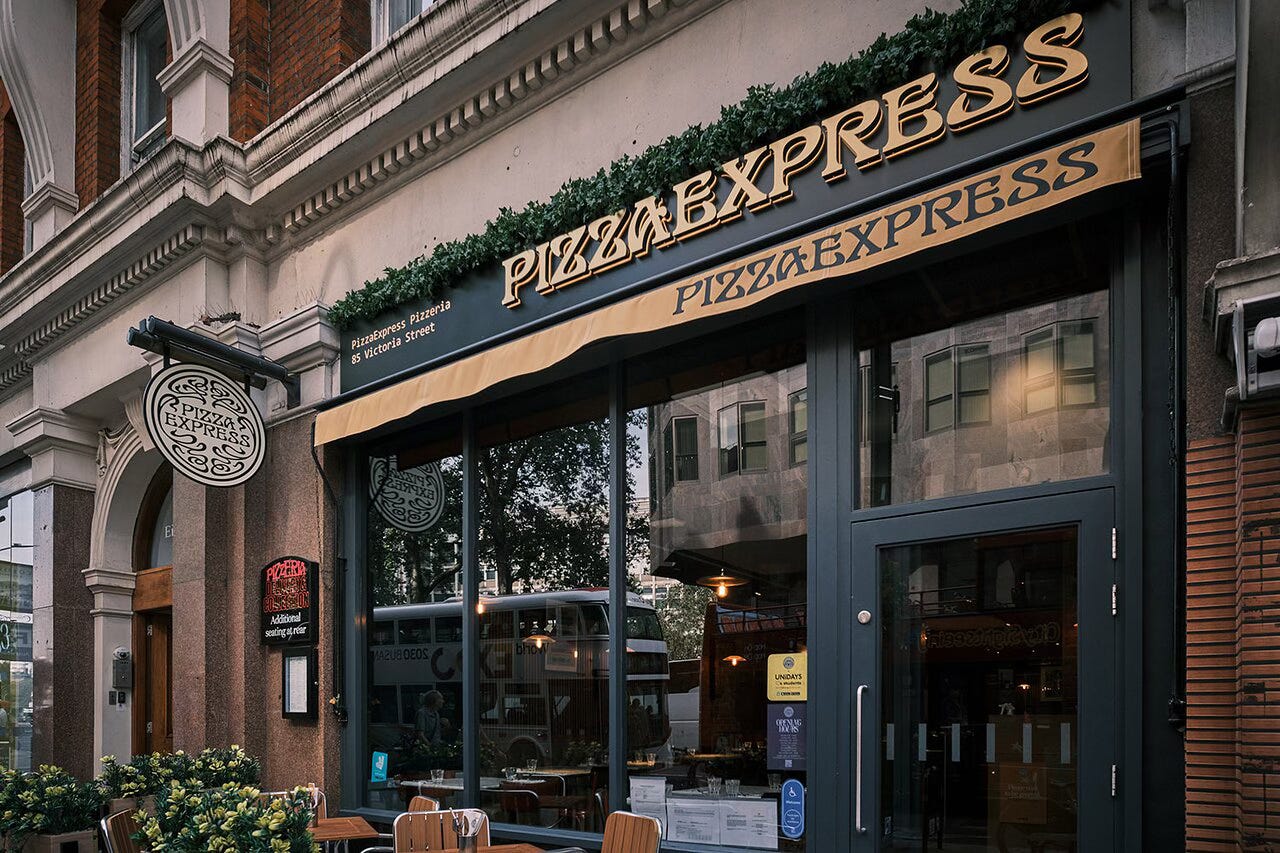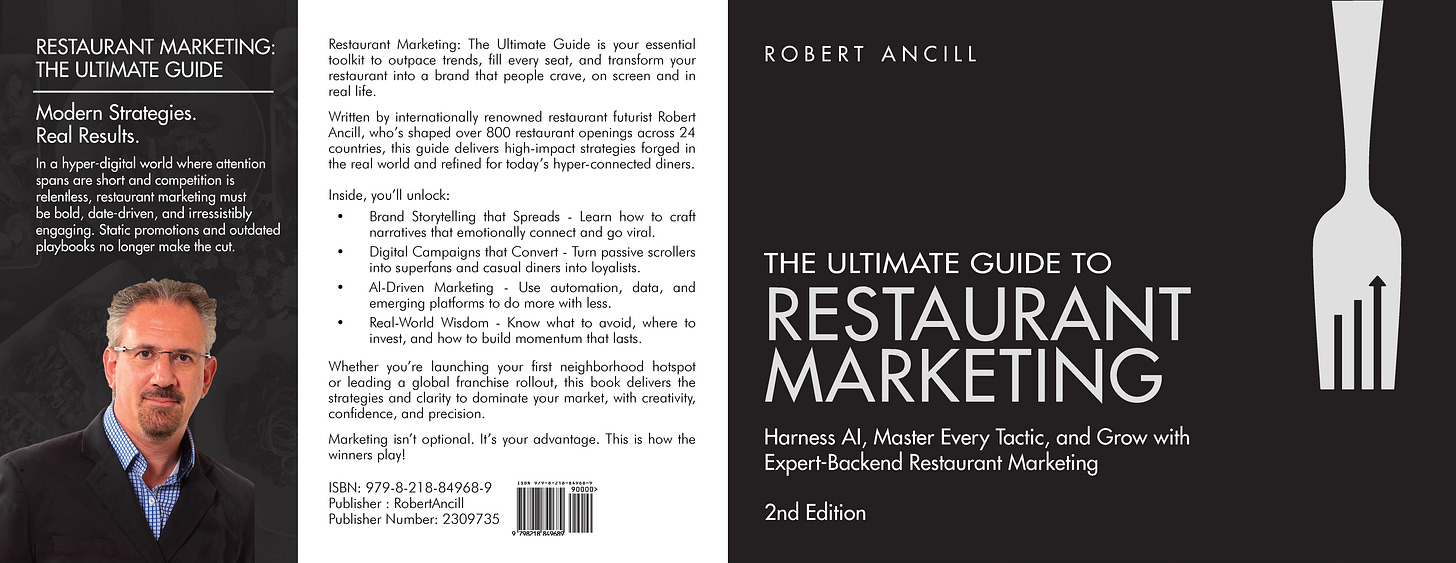The Curious Case of Pizza Hut
Evolving Taste, Timeless Lessons: What Pizza Hut Teaches Us About Change
Let’s face it, Pizza Hut was the pizza place. For decades, its red-roofed dine-in restaurants symbolized family gatherings, affordable indulgence, and a distinct American brand of casual dining. Yet, in a surprising turn of events, Yum! Brands recently announced that it is initiating a formal strategic review of Pizza Hut’s business, a process that could lead to a full divestiture, a spin-off, or another structural transformation.
According to Yum’s CEO, Pizza Hut’s current performance “indicates the need to take additional action … which may be better executed outside of Yum Brands.” That statement is carefully measured, but the subtext is telling. It implies that Yum, one of the world’s largest restaurant conglomerates, may no longer see Pizza Hut as aligned with its operational strengths or growth strategy
This raises a fundamental question: is Pizza Hut’s struggle a symptom of brand fatigue, executional failure, or a larger shift in consumer dynamics that Yum no longer feels equipped to manage?
1. The Numbers Never Lie
In the U.S., Pizza Hut’s same-store sales have dropped notably. During Q1 2025, U.S. sales were down by about 5%, and worldwide same-store sales slipped another 2%. Against the backdrop of competitors’ growth, these figures look even more troubling.
Consider Domino’s, which has thrived despite similar macroeconomic pressures:
• Global retail sales growth (excluding currency impacts): +4.7%
• U.S. same-store sales: -0.5%
• International same-store sales: +3.7%
• Total revenue: up ~2.5% year-over-year to US $1.11 billion
• Net income: up +18.9%
While Domino’s continues to build on its digital prowess and delivery-first infrastructure, Pizza Hut’s legacy footprint still leans heavily on the dine-in model, a model that has increasingly fallen out of favor with post-pandemic consumer behavior.
2. The Dine-In Dilemma and the Value Void
The decline of Pizza Hut’s dine-in relevance is a central part of the story. The brand that once differentiated itself with cozy, red-roofed restaurants and family-friendly buffets is now lagging in an industry dominated by speed, convenience, and digital accessibility.
As AP News noted, “More consumers are ordering for pickup and delivery and favor brands that excel in that model, Pizza Hut has been criticized for being too dine-in focused historically.”
Moreover, the company’s value proposition has grown increasingly unclear. In an intensely competitive quick-service landscape, brands like Little Caesars, Papa John’s, and Domino’s have aggressively communicated price-driven deals and loyalty rewards. Pizza Hut’s messaging, by contrast, has felt inconsistent, oscillating between premium product pushes and generic “value box” promotions.
Reuters summarized this challenge succinctly: “Pizza Hut’s value message has been deemed insufficient to compete in a crowded value-oriented space.”
3. Redefining ‘Value’, The Rise of Innovation and Quality
Yet perhaps the more intriguing development is that value may not even be the right battleground anymore. Much of the most dynamic growth in the U.S. pizza sector isn’t coming from low-price competition, but rather from innovation, brand authenticity, and product quality.
A compelling example is Slice House, the fast-casual brand created by world-renowned pizzaiolo Tony Gemignani. The original Slice House opened in 2010 in San Francisco as a small, delivery-friendly offshoot of Gemignani’s full-service restaurant. Its model, quick carryout, artisanal ingredients, and high-quality variety, thrived amid pandemic-era consumer shifts.
By mid-2024, Slice House had 124 units open or in development across California, Texas, Utah, Colorado, and Tennessee, and was named #1 Emerging Brand and #1 Top Pizza Brand by Pizza Marketplace in both 2023 and 2024.
The takeaway is profound: customers are increasingly willing to pay more for quality, not less for quantity. This trend mirrors the “better burger” revolution of the mid-2000s, when chains like Shake Shack and Five Guys redefined fast-casual dining around freshness and craftsmanship. Consumers who once sought the cheapest combo meal began seeking the best, fresh ingredients, storytelling, and pride in product.
4. The Price Reality Check: Pizza Hut vs. Slice House
The striking point isn’t the price gap, it’s the consumer willingness to pay it. Despite costing nearly twice as much, Slice House continues to expand rapidly. That indicates a decisive market shift away from “cheap pizza” and toward “quality pizza.” Pizza Hut remains trapped in the shrinking middle, neither premium enough to excite enthusiasts nor value-oriented enough to appeal to bargain hunters.
5. Lessons from Pizza Express: Reinvention through Menu Innovation
Across the Atlantic, Pizza Express in the U.K. offers a useful comparison, and a lesson in adaptive brand evolution.
Founded in 1965, Pizza Express long held a reputation as a stylish yet accessible casual dining chain. However, by the late 2010s, it faced the same challenges Pizza Hut now grapples with: menu fatigue, inconsistent value perception, and an outdated dine-in format.
In response, Pizza Express embarked on a comprehensive brand review in 2021–2022. This included:
• A revamped menu emphasizing lighter, modern dishes and premium ingredients (e.g., vegan and gluten-free options, “Leggera” pizzas, and curated appetizers).
• A redesigned restaurant experience, with more open layouts, contemporary aesthetics, and faster service.
• Integration of digital ordering, loyalty programs, and data-driven customer engagement.
The results were telling. The refreshed brand achieved stronger average transaction values, greater customer retention, and renewed cultural relevance, particularly among younger, experience-driven diners.
Importantly, Pizza Express learned that a static menu can only succeed in rare exceptions, such as In-N-Out Burger, where simplicity is part of the brand mythos. For most legacy chains, continuous menu evolution is not optional, it’s existential.
6. The Franchise Factor and Brand Fatigue
Another dimension of Pizza Hut’s struggle lies in its franchise structure. In recent years, several large franchise groups have faced bankruptcies and closures, undermining the brand’s footprint.
While the causes vary, rising food costs, operational complexity, and pandemic disruptions, the pattern reflects a deeper issue: Pizza Hut’s model may no longer be financially compelling for operators.
In contrast, Slice House’s streamlined kitchens, simplified menus, and efficient layouts offer an attractive model for modern franchisees, lower labor dependency, faster throughput, and minimal real estate overhead. The irony is unmistakable: the very fast-casual pivot that Pizza Hut once inspired is now being perfected by smaller, nimbler upstarts.
7. Lessons from the ‘Better Burger’ Revolution
The early 2000s saw a redefinition of fast food, as “better burger” concepts like Shake Shack and Five Guys captured audiences through freshness, transparency, and experience. These brands didn’t compete on price, they competed on perceived integrity. The result was an industry bifurcation: legacy QSRs doubled down on speed and value, while a new class of fast-casual innovators seized the premium niche.
Pizza Hut now faces the same crossroads. Its challenge isn’t merely modernization, it’s choosing a lane. It must either embrace a low-cost, delivery-optimized model like Domino’s, or reinvent itself as a quality-driven fast-casual concept rooted in craft and heritage.
8. The Red Roof Reimagined
The “curious case” of Pizza Hut is less about corporate mismanagement and more about evolutionary inertia. For decades, its identity was tied to nostalgia, the red roof, the dine-in experience, the salad bar. But consumer dining has evolved irreversibly.
Yum!’s potential decision to spin off or divest Pizza Hut may, paradoxically, be the brand’s best hope. Freed from corporate constraints, it could rediscover its soul, blending its heritage of bold flavor and community with modern tech, digital-first convenience, and even automation or robotics.
If Pizza Hut can unite that past and future, pairing its cultural warmth with innovation and quality, it could yet stage a renaissance. But time is short. The future of pizza will not be decided by size or history, but by courage, creativity, and authenticity. Relevance is the new currency of dining, and, as many restaurant brands have discovered, it depreciates quickly.
Robert Ancill is a globally recognized restaurant consultant, design innovator, and trend forecaster. Based in Los Angeles and originally from Glasgow, Scotland, he founded The Next Idea Group in 2002, a hospitality concept and design agency that has led more than 800 restaurant and café launches across 24 countries. A respected authority on food service innovation, franchising, and emerging consumer trends, he also serves as Chairman of Heritage Restaurant Consultants and as a board advisor to the AI-powered experience platform Atmosfy.
A leading futurologist in hospitality, Robert produces annual trend reports covering robotics, AI, plant-based innovation, and the evolution of casual dining. His upcoming trilogy of books begins with Restaurant Marketing: The Ultimate Guide to Modern Restaurant Marketing (published 2025), offering a comprehensive playbook for thriving in today’s tech-driven marketplace. His next books is The Ultimate Guide to Restaurant Design will be available from 20th November 2025.
Websites
Books: The Ultimate Guide to Modern Restaurant Marketing At Sale price (Valid to Nov 20th 2025)
https://www.Heritagerestaurantconsultants.com
https://www.thenextideagroup.com
https://www.globalrestaurantconsultant.com
https://www.robertancill.com
https://www.linkedin.com/in/robertancill









